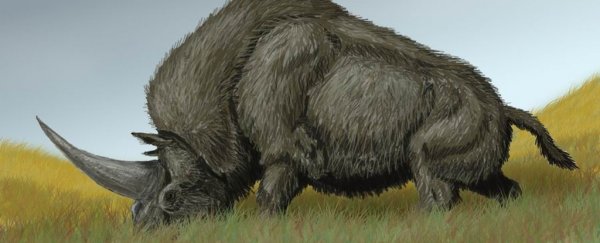It didn't look much like the dainty unicorns of myth and legend, but the extinct unicorn of Siberia is even more entrancing for palaeontologists.
Now, for the first time, scientists have analysed its DNA - and realised everyone had been wrong about the mysterious beast.
The ancient rhinoceros didn't die off 200,000 years ago, before the last Ice Age - as we previously thought. The strange animals survived much, much longer, only disappearing as recently as 36,000 years ago. In fact, they could have lived alongside modern humans.
Moreover, the Siberian unicorn was not, as had been thought, closely related to modern rhinos, but a unique lineage that split from the line that led to modern rhinos over 40 million years ago.
Until now, our knowledge of the unicorn (Elasmotherium sibiricum) has been stymied because of the lack of fossil record.
Only a few fragmented bones have been recovered, and apart from revealing the size of the beast - around 3.5 tonnes, the same range as a smaller African elephant - those have been difficult to analyse.
For example, part of a skull that was described in a 2016 paper was radiocarbon dated up to 29,000 years ago, but because there was so little collagen, the result was considered unreliable.
So an international team of researchers collected 23 Siberian unicorn bone specimens and subjected them to radiocarbon dating, to see if they could recover DNA and find out more about the Siberian unicorn and its time on Earth.
The results were surprising: they were dated to a range of times after the animals were thought to be extinct, with the most recent being between 35,000 to 36,000 years ago. By this time, humans had started populating the steppe of Russia, Kazakhstan, Mongolia and Northern China.
But humans likely had nothing to do with the animal's disappearance.
"If we look at timing, it's during a period of climate change, which wasn't extreme, but it did cause a whole bunch of much colder winters that we think really altered the extent of the grassland in the area," Alan Cooper of the Australian Centre for Ancient DNA at the University of Adelaide explained to ScienceAlert.
"We can also see the change in the isotopes in the bones of the animals - you can see and measure the carbon and the nitrogen in the bones and we can see that it was only eating grass."
At around the same time, other animals in the area that ate grass started to switch their diets to herbs, shrubs and whatever other vegetation they could sink their teeth into, but not the Siberian unicorn. It kept on munching on grass, even as, the researchers believe, encroaching permafrost killed it off.
"It looks like this unicorn thing was so specialised to eat grass it couldn't survive," Cooper said.
"Its head was a whopping great big thing, it was kind of extended really really low, sitting right at grass height, so it really doesn't have to lift its head up. There's question of whether it could even lift its head at all! It was highly specialist so once the environment shifted it appears to have died out."
We don't know how big the animal's horn grew, since no horn has ever been found. However, the part of the skull where the horn would have grown has been recovered, with an absolutely massive base. Based on comparisons with living horned animals, the Siberian unicorn's horn could have been up to 1 metre (3.3 feet) in length.
Combined with its big, heavy head, this horn could have made reaching higher foliage even more difficult for the ancient rhino. But if its lineage was tens of millions of years old, the species had survived several climate change events already.
Exactly why this particular, relatively mild cooling event was the straw that broke the unicorn's back is still a bit of a mystery, and one that will take more research to unravel. But it does constitute a warning we would do well to heed.
"The worrying thing about it is it shows you don't have to have major climate change to have vegetation responses that can wipe out a species - and this is before humans had restricted animals' ranges. Can you imagine what will happen today?" Cooper said.
"That's why people are looking at large grasslands such as Africa. But what about food production? Similar kind of stuff - once these climate changes start getting in the way the environment can have some pretty big impacts and quickly."
The team's research has been published in the journal Nature Ecology & Evolution.
